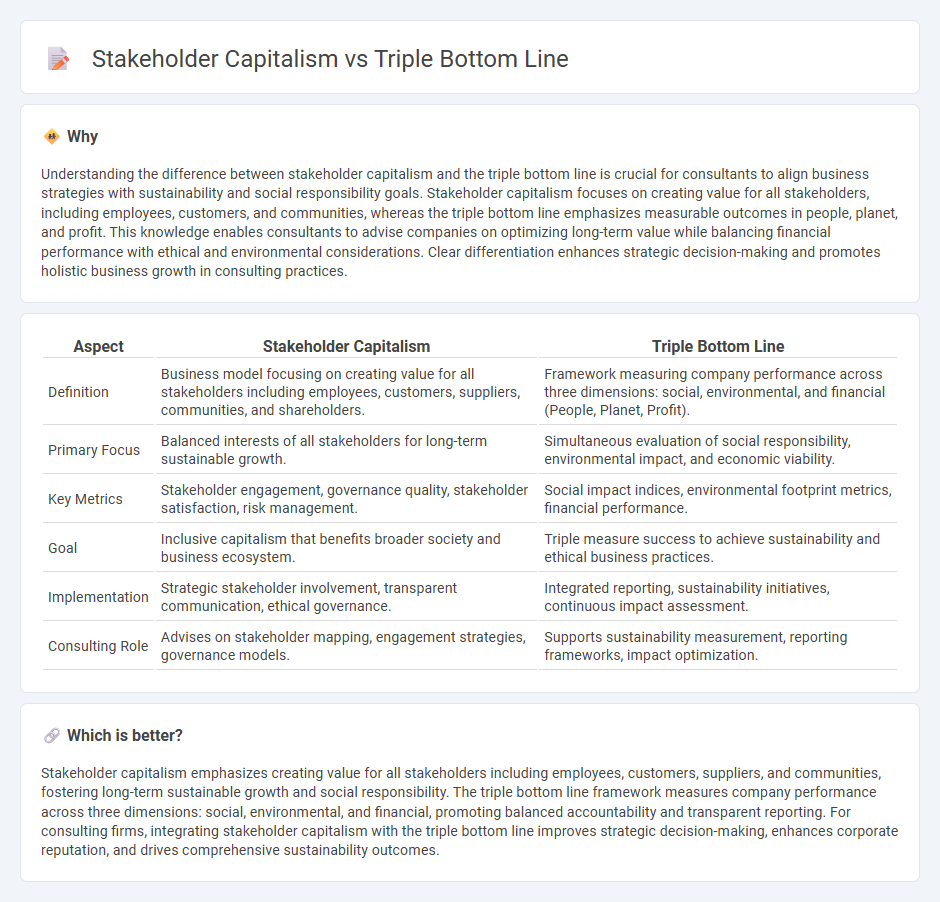
Stakeholder capitalism emphasizes creating value for all parties involved, including employees, customers, suppliers, communities, and shareholders, focusing on long-term sustainable growth. The triple bottom line framework expands this approach by measuring a company's success through social, environmental, and financial performance, balancing profit with purpose. Explore how integrating these models drives responsible business strategies and enhances corporate impact.
Why it is important
Understanding the difference between stakeholder capitalism and the triple bottom line is crucial for consultants to align business strategies with sustainability and social responsibility goals. Stakeholder capitalism focuses on creating value for all stakeholders, including employees, customers, and communities, whereas the triple bottom line emphasizes measurable outcomes in people, planet, and profit. This knowledge enables consultants to advise companies on optimizing long-term value while balancing financial performance with ethical and environmental considerations. Clear differentiation enhances strategic decision-making and promotes holistic business growth in consulting practices.
Comparison Table
| Aspect | Stakeholder Capitalism | Triple Bottom Line |
|---|---|---|
| Definition | Business model focusing on creating value for all stakeholders including employees, customers, suppliers, communities, and shareholders. | Framework measuring company performance across three dimensions: social, environmental, and financial (People, Planet, Profit). |
| Primary Focus | Balanced interests of all stakeholders for long-term sustainable growth. | Simultaneous evaluation of social responsibility, environmental impact, and economic viability. |
| Key Metrics | Stakeholder engagement, governance quality, stakeholder satisfaction, risk management. | Social impact indices, environmental footprint metrics, financial performance. |
| Goal | Inclusive capitalism that benefits broader society and business ecosystem. | Triple measure success to achieve sustainability and ethical business practices. |
| Implementation | Strategic stakeholder involvement, transparent communication, ethical governance. | Integrated reporting, sustainability initiatives, continuous impact assessment. |
| Consulting Role | Advises on stakeholder mapping, engagement strategies, governance models. | Supports sustainability measurement, reporting frameworks, impact optimization. |
Which is better?
Stakeholder capitalism emphasizes creating value for all stakeholders including employees, customers, suppliers, and communities, fostering long-term sustainable growth and social responsibility. The triple bottom line framework measures company performance across three dimensions: social, environmental, and financial, promoting balanced accountability and transparent reporting. For consulting firms, integrating stakeholder capitalism with the triple bottom line improves strategic decision-making, enhances corporate reputation, and drives comprehensive sustainability outcomes.
Connection
Stakeholder capitalism integrates the triple bottom line framework by focusing on social, environmental, and financial performance to create sustainable value for all parties involved. This approach ensures businesses prioritize people, planet, and profit equally, aligning corporate strategies with broader societal goals. Emphasizing stakeholder interests drives long-term growth and enhances corporate responsibility within ethical and sustainable consulting practices.
Key Terms
Sustainability
Triple bottom line emphasizes measuring performance through social, environmental, and financial outcomes, promoting sustainability by balancing profit, people, and the planet. Stakeholder capitalism prioritizes the interests of all stakeholders, including employees, customers, communities, and shareholders, fostering long-term sustainable value. Explore how these frameworks drive corporate responsibility and sustainable growth.
Social Responsibility
The triple bottom line framework evaluates business success based on social, environmental, and economic impacts, emphasizing corporate social responsibility to benefit communities and employees. Stakeholder capitalism prioritizes the interests of all stakeholders, including customers, suppliers, and society, aiming for sustainable value creation beyond shareholder profits. Explore the distinctions between these models to understand their unique approaches to social responsibility.
Profit Maximization
Triple bottom line prioritizes balanced outcomes across profit, people, and planet, integrating social and environmental responsibilities with financial performance. Stakeholder capitalism emphasizes maximizing value for all stakeholders, including employees, customers, suppliers, and communities, rather than focusing solely on short-term profit maximization. Discover how these frameworks reshape corporate strategies beyond traditional profit goals.
Source and External Links
What Is the Triple Bottom Line (TBL)? - The triple bottom line (TBL) is a sustainability framework focused on maximizing three key elements: people (social impact), planet (environmental impact), and profit (financial performance), ensuring businesses create value for all stakeholders, not just shareholders, by integrating social equity, ecological responsibility, and economic goals.
Why You Should Pay Attention to the Triple Bottom Line - The triple bottom line expands traditional accounting to measure success in profits, people, and planet, serving both as a reporting tool and a framework for sustainable business that balances financial goals with social and environmental responsibility.
Triple bottom line - The triple bottom line is an accounting framework composed of three parts: social equity (people), environmental stewardship (planet), and economic viability (profit), coined by John Elkington in 1994, emphasizing fair business practices, community benefit, and ecological sustainability alongside financial success.
 dowidth.com
dowidth.com